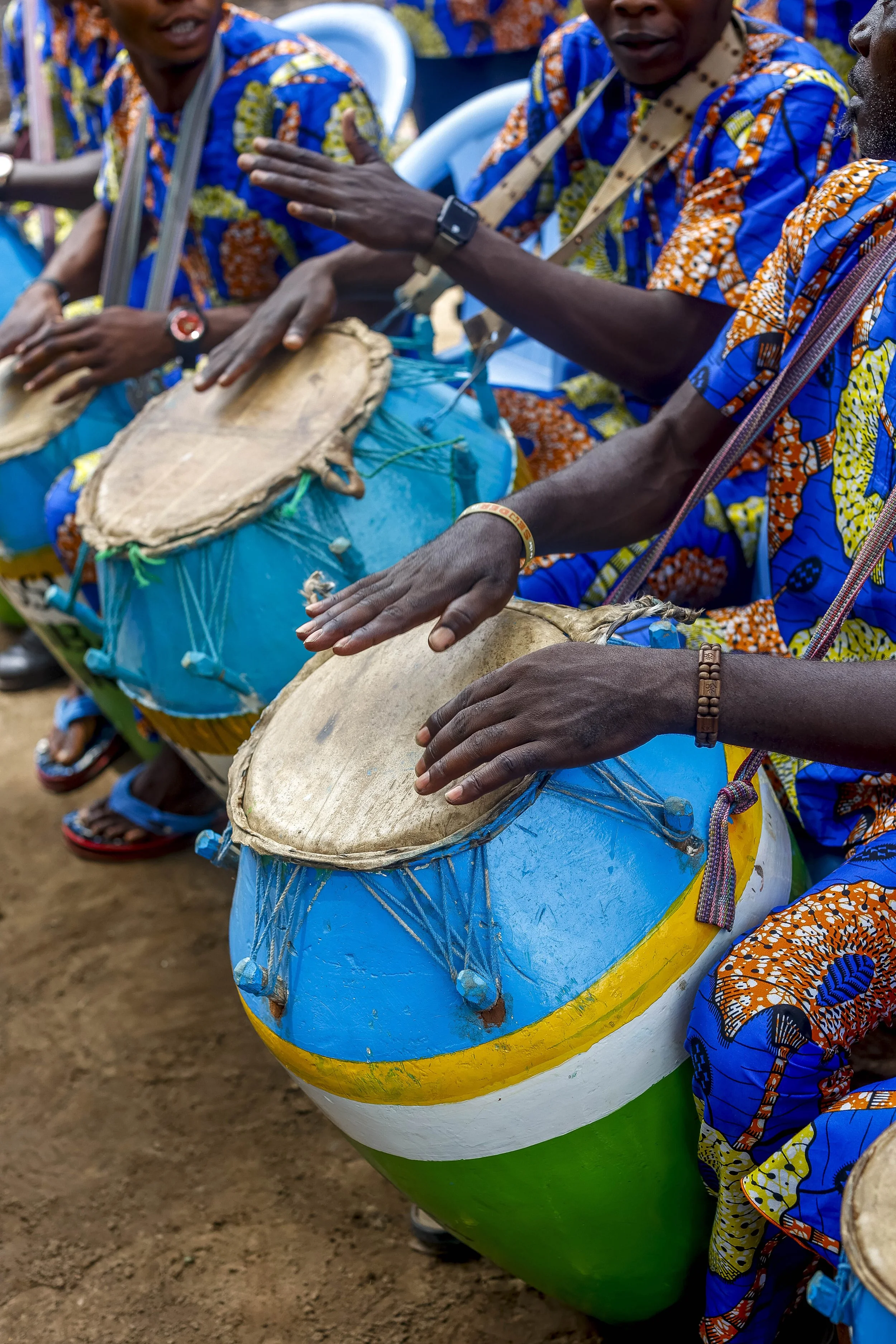RECORDED MUSIC INDUSTRY OVERVIEW
Togo
Africa
Potential of Recorded Music
MEDI aims to highlight music’s potential as a global tool to reduce poverty and drive economic growth by estimating its worldwide value. This includes projecting how that value could increase if every country had supportive institutions in place, such as appropriate legislation, infrastructure, and policies, and if music achieved full market penetration. We are currently collecting data in each country to support this analysis.
Coming soon
Coming soon
Coming soon
Local Impact
Over time, MEDI will conduct country-level economic and social impact assessments to better understand how to unlock sustainable growth within national music ecosystems.
Coming soon
Coming soon
Coming soon
Coming soon
Coming soon
Coming soon

Socioeconomic Indicators
EXPLANATORY NOTES: Data via UN Population Fund (UNFPA). Accessed 24/10/2024. 2024 estimate based on UNFPA World Population Prospects 2022 data.
9,260,865
EXPLANATORY NOTES: Data via World Bank Development Indicators database. Accessed 24/10/2024.
$25,750
EXPLANATORY NOTES: Data via World Bank, using national accounts data, and OECD National Accounts data files. Accessed 02/04/2025.
$985.70
6.41%
EXPLANATORY NOTES: Data via World Bank, using national accounts data, and OECD National Accounts data files. Accessed 01/04/2025.
EXPLANATORY NOTES: Data via World Bank, Poverty and Inequality Platform. Accessed 19/09/2024.
37.9%
EXPLANATORY NOTES: Data via IMF World Economic Outlook. Accessed 01/04/2025.
2.3%
EXPLANATORY NOTES: Data via US Census Bureau International Database (IDB). Accessed 01/04/2025.
EXPLANATORY NOTES: Data via World Bank, using United Nations Population Division database. Accessed 24/10/2024.
44.49%
EXPLANATORY NOTES: Data via CIA World Factbook. Accessed 04/11/2024.
2.05%
EXPLANATORY NOTES: Data via CIA World Factbook. Accessed 04/11/2024.
3.3%
EXPLANATORY NOTES: Poverty rate at $2.15 a day (2017 PPP) (% population). Data via Poverty and Inequality Platform, The World Bank. Accessed 16/04/2025.
26.59%
EXPLANATORY NOTES: Data via International Telecommunication Union (ITU) DataHub. Accessed 31/03/2025.
37.60%
EXPLANATORY NOTES: Data via World Bank Global Financial Inclusion Database. Accessed 01/04/2025.
36.48%
EXPLANATORY NOTES: Data via World Bank Global Financial Inclusion Database. Accessed 01/04/2025.
1.52%
EXPLANATORY NOTES: Data via Cable.co.uk. Accessed 01/10/2024.
$1.45

Industry Infrastructure
Collective Management Organisations
Authors & Publishers
Performers
Producers
Voluntary Joint Ventures & Umbrella entities for licensing users
None
Associations
Music Authors
Music Publishers
None
Music Performers
Sound Recording Producers/Labels
None
Other
Music Export Office
None
Joint Industry Body
None
Policies
Culture Policy/Strategy
None
Music Policy/Strategy
None
Legal Framework
Digital and Performance Rights Treaties
Other Treaties
National Copyright Legislation
National Treatment
-
Togo protects foreign authors who domicile in Togo, whose works are first published in Togo and based on reciprocity, which is determined jointly by the Minister of Culture and the Minister of Foreign Affairs.
Qualifying foreign authors enjoy protection concerning reproduction rights and performance rights. -
Togo protects the rights of foreign performers and producers of phonograms in accordance with the treaties Togo is a party.
Togo also protects the rights of foreign performers whose habitual residence is in Togo, performance takes place in Togo, is fixed in the protected phonogram or included in the protected broadcast (i.e., when the headquarters of the broadcasting organisation is located in Togo or the transmitting station is located in Togo). Phonograms are protected if the producer is a national of Togo, if the first fixation of sound was made in Togo and if the phonogram was first published in Togo.
Qualifying foreign producers of phonograms enjoy protection concerning reproduction, distribution and performance rights. Qualifying performers enjoy protection concerning reproduction and performance rights. -
“National Treatment” refers to the assimilation of the treatment of foreign right holders to that of domestic right holders. It is a basic rule of most international conventions and mandates that foreign rights holders from contracting countries must receive the protection within any other contracting country as that country grants to its own nationals, ensuring equal rights under the scope of the relevant convention.
General national treatment obligations are set out in Article 5 of the Berne Convention and Article 2 of the Rome Convention, providing that the members of respective conventions must grant to each other’s nationals the rights provided in the convention. Berne Convention also extends the national treatment to “the rights which their respective laws do now or may hereafter grant to their nationals,” while Rome Convention members are not obliged to extend national treatment to the rights of performers and producers of phonograms which are accorded under their national law over and above the rights enshrined in the Rome Convention.
The criteria for eligibility for protection are provided in Article 3 of the Berne Convention and Articles 4 and 5 of the Rome Convention. With regards to national treatment of producers of phonograms, members of the Rome Convention may reserve the right not to apply either the criterion of fixation or that of publication of the phonogram.
As per WIPO, the total number of members to the key treaties above is as follows:
Berne Convention: 181 Members
Rome Convention: 98 Members
WIPO Copyright Treaty: 118 Members
WIPO Performances and Phonograms Treaty: 114 Members
TRIPS Agreement: 166 MembersThis is a high-level overview concerning national treatment of music authors, performers and producers of phonograms; for comprehensive and detailed provisions, refer to the laws of each country. The overview:
1) details only the criteria applicable to foreign rights holders, without including the broader set of qualification rules for domestic protection that do not concern them,
2) is limited to performance rights and digital exploitation of recorded music, including works and other protected objects:
- “Performance rights” include radio and TV broadcasting, public performance, and communication to the public,
- “Digital exploitation” includes reproduction rights, distribution rights, communication to the public and making available rights.
The term "based on reciprocity" used in the overview for some countries means that Country A will protect the works of authors or other right holders who are nationals of Country B that is not a member of treaties Country A is a party to, and whose works or other protected objects were first published outside of Country A, only if Country B offer similar copyright protection to Country A’s authors or other rights holders and works and other protected objects respectively first published in Country A.
The term "treaty" in the overview includes conventions and international agreements.
Music Consumption
Domestic Repertoire Quotas
Yes
There is a domestic repertoire quota for broadcasters, requiring that both private and community radio and television broadcasters undertake to promote Togolese culture by granting a quota of at least 60% of content broadcast to national production, songs, and music of Togolese expression.
The full text of the quota may be found in Articles 39 and 47 of Arrete N°04/HAAC/19/P - Portant Cahier des Charges et Obligation Générales des Sociétés de Radiodiffusion Sonore er de Télévision Privées Commerciales, as regulated by the Haute Autorité de l’Audiovisuel et de la Communication (HAAC).
Digital Streaming Services
GLOBAL STREAMING SERVICES
REGIONAL STREAMING SERVICES
DOMESTIC STREAMING SERVICES
None
Key Risks and Opportunities
Risks
Low nominal GDP per capita and a relatively high poverty rate mean that many consumers have limited disposable income for music, potentially restricting the growth of premium subscriptions and paid downloads.
Relatively low internet penetration and high mobile data costs limit the immediate reach of online streaming services and may hinder frequent usage, negatively impacting music consumption.
The absence of a national culture or music policy indicates a lack of strategic direction and structured government support for the sector. Additionally, Togo’s copyright legal framework requires updating to address digital rights protection and to strengthen enforcement in line with the international treaties it has ratified.
The numerous music associations, while positive for representation, might also indicate a fragmented industry that requires cohesive strategies to scale effectively.
Opportunities
A stable inflation rate supports a predictable economic environment, while GDP growth signals a positive economic trajectory. Together, these trends suggest the potential for rising disposable income and increased consumer spending on music over the long term.
A large youth population represents a significant, future-oriented consumer base for music and digital content. High levels of urbanization further concentrate and enhance access to this market segment.
Togo’s adherence to key international copyright treaties is a positive step. However, accelerating the adoption and implementation of the draft copyright bill is essential to establish a strong legal foundation for intellectual property protection, which is crucial for attracting and securing investment.









